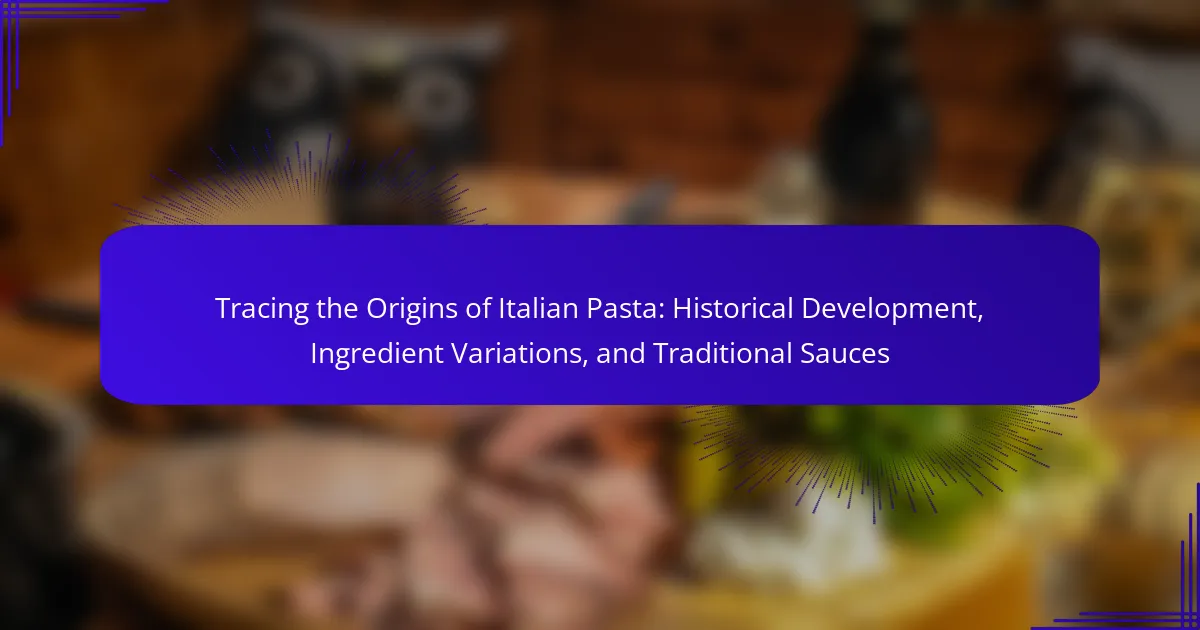
What are the historical roots of Italian pasta?
Italian pasta has historical roots that trace back to ancient civilizations. The earliest evidence of pasta-like dishes dates to the Etruscans, around 400 BC. They made a form of dough from wheat and water. This practice evolved over centuries, influenced by various cultures. The introduction of durum wheat in the Middle Ages improved pasta quality. By the 13th century, pasta became a staple in Italian cuisine. The first documented mention of pasta in Italy appeared in a 1154 text by Arab geographer Al-Idrisi. This highlights the cultural exchanges that shaped pasta’s development. By the Renaissance, pasta was widely consumed across Italy, solidifying its place in Italian gastronomy.
How did pasta evolve in Italy over the centuries?
Pasta evolved in Italy over the centuries through various influences and innovations. Its origins trace back to ancient civilizations, with evidence of pasta-like dishes in Etruscan and Roman times. By the Middle Ages, durum wheat became the primary ingredient, leading to the development of dried pasta. The 14th century saw the introduction of different shapes and forms, influenced by regional tastes. The Renaissance period popularized pasta across Italy, with recipes appearing in cookbooks. By the 19th century, pasta became a staple in Italian cuisine, with the establishment of factories for mass production. Today, Italy boasts hundreds of pasta varieties, showcasing regional differences and traditional methods.
What significant events influenced the development of pasta?
The development of pasta was influenced by several significant events. The introduction of durum wheat in ancient times allowed for the creation of pasta. The Arab invasion of Sicily in the 9th century brought new cooking techniques and ingredients. The establishment of trade routes in the Middle Ages increased the availability of various pasta shapes. The publication of the first known pasta recipe in the 14th century marked a turning point in its culinary significance. The Industrial Revolution in the 19th century led to mass production, making pasta widely accessible. The rise of Italian immigration in the late 19th and early 20th centuries spread pasta culture globally. Each event contributed to the evolution and popularity of pasta as a staple food.
Which regions in Italy are known for their unique pasta histories?
Emilia-Romagna, Campania, and Liguria are regions in Italy known for their unique pasta histories. Emilia-Romagna is famous for its rich tradition of handmade pasta, including tagliatelle and tortellini. Campania is recognized for its iconic dishes featuring pasta like spaghetti and ziti, often paired with fresh tomatoes. Liguria is celebrated for its trofie and pansoti, showcasing local ingredients like basil and pine nuts. Each region’s pasta reflects its agricultural heritage and local culinary practices. The historical significance of these pasta types is well-documented in Italian culinary literature.
What role did trade and cultural exchange play in pasta’s origins?
Trade and cultural exchange significantly influenced pasta’s origins. The introduction of durum wheat from the Middle East to Italy played a crucial role. This wheat was essential for making pasta due to its high gluten content. Additionally, the Arab presence in Sicily during the 9th century brought new cooking techniques and recipes. These cultural interactions led to the development of various pasta shapes and dishes. Historical texts, such as “The Art of Cooking” by Maestro Martino, highlight these influences. The spread of pasta across Europe was facilitated by trade routes established during the Middle Ages. This exchange not only popularized pasta but also diversified its forms and ingredients.
How did the introduction of new ingredients affect pasta?
The introduction of new ingredients significantly transformed pasta. New ingredients expanded the variety of pasta shapes and textures. For example, the use of whole grains led to more nutritious options. Innovations like spinach or beetroot introduced vibrant colors. Additionally, gluten-free alternatives became popular with the rise of dietary restrictions. These changes allowed for greater culinary creativity and adaptation. Historical records show that pasta evolved from simple flour and water to include diverse components. This evolution reflects regional tastes and dietary needs across Italy.
What historical figures contributed to pasta’s popularity?
Marco Polo significantly contributed to pasta’s popularity in the late 13th century. His travels to China introduced European cultures to noodles, influencing Italian cuisine. In Italy, figures like Francesco Marcolini promoted pasta in the 16th century. He published a cookbook that included various pasta recipes. Another key figure is Pellegrino Artusi, whose 1891 cookbook helped standardize pasta dishes. His work brought pasta to the forefront of Italian culinary tradition. These historical figures played crucial roles in pasta’s evolution and acceptance across Europe.

What are the key ingredient variations in Italian pasta?
Key ingredient variations in Italian pasta include flour types, egg content, and additional ingredients. The primary flour used is durum wheat semolina, known for its high protein content. Some pasta varieties use all-purpose flour for a softer texture. Egg pasta, or “pasta all’uovo,” includes eggs, resulting in a richer flavor and yellow color. Additionally, some pasta incorporates spinach or beetroot for color and flavor variations. Regional differences also influence ingredients; for instance, northern Italy often uses more eggs in pasta. These variations reflect local traditions and culinary practices across Italy.
How do different flours impact pasta types?
Different flours significantly impact pasta types by altering texture, flavor, and cooking properties. Durum wheat flour creates firm pasta, ideal for shapes like spaghetti and penne. Semolina, a coarser form of durum, enhances bite and structure. All-purpose flour yields softer pasta, suitable for delicate varieties like ravioli. Whole wheat flour adds nuttiness and a denser texture, affecting the overall taste. Gluten-free flours, such as rice or chickpea, produce unique textures and flavors, catering to dietary needs. The choice of flour influences hydration levels and cooking times, which are critical for achieving desired pasta characteristics.
What are the common types of flour used in pasta making?
The common types of flour used in pasta making are semolina flour, all-purpose flour, and00 flour. Semolina flour is made from durum wheat and has a high protein content. This type of flour gives pasta its firm texture. All-purpose flour is versatile and can be used for various pasta types. It has a moderate protein content, making it suitable for softer pasta. 00 flour is finely milled and is often used in traditional Italian pasta recipes. This flour creates a smooth dough, ideal for delicate pasta shapes. Each type of flour contributes distinct qualities to the pasta, affecting its texture and cooking properties.
How does the choice of flour affect texture and flavor?
The choice of flour significantly affects the texture and flavor of pasta. Different types of flour contain varying levels of protein and gluten. High-protein flours, like durum wheat, create a firmer texture and a chewier bite. This is ideal for traditional pasta, which needs to hold its shape during cooking. Low-protein flours, such as all-purpose flour, yield a softer texture and can result in a more tender pasta.
Additionally, the milling process influences flavor. Whole wheat flour retains the bran and germ, imparting a nuttier taste. In contrast, refined flours have a milder flavor due to the removal of these components. Regional preferences also play a role, with certain areas favoring specific flour types for distinct pasta styles.
For instance, southern Italy predominantly uses durum wheat flour for its robust flavor and texture. Studies show that the protein content in flour directly correlates with the pasta’s cooking quality and mouthfeel. Therefore, selecting the right flour is crucial for achieving the desired characteristics in pasta dishes.
What other ingredients are essential in pasta production?
Water and flour are essential ingredients in pasta production. The flour provides the necessary starch and protein structure. Durum wheat flour is commonly used for its high gluten content. Water hydrates the flour, allowing the formation of dough. Salt is often added to enhance flavor and strengthen the dough. Eggs are also included in some pasta varieties, contributing richness and color. Olive oil may be used to improve texture and prevent sticking. These ingredients combine to create the diverse forms of pasta enjoyed worldwide.
How do eggs influence the characteristics of pasta?
Eggs significantly influence the characteristics of pasta. They contribute to the pasta’s texture, flavor, and color. The inclusion of eggs results in a richer, denser dough. This enhances the pasta’s elasticity and chewiness. Pasta made with eggs tends to hold sauces better. It also exhibits a vibrant yellow hue, which is visually appealing. Historically, egg pasta is associated with certain regional varieties, such as tagliatelle and fettuccine. The use of eggs in pasta dates back to the Middle Ages in Italy, showcasing its long-standing culinary tradition.
What role does water play in the pasta-making process?
Water is essential in the pasta-making process. It hydrates the flour, activating gluten formation. This gluten gives pasta its structure and elasticity. The amount of water affects the dough’s consistency. Typically, a ratio of one part water to two parts flour is used. Water also helps in mixing ingredients evenly. It can influence the cooking time and texture of the final product. Studies show that proper hydration improves pasta’s cooking quality and taste.

What traditional sauces complement Italian pasta?
Traditional sauces that complement Italian pasta include marinara, Alfredo, and pesto. Marinara is a tomato-based sauce with garlic and herbs. Alfredo features cream, butter, and Parmesan cheese. Pesto is made from basil, garlic, pine nuts, and olive oil. Each sauce has roots in Italian culinary traditions. For instance, marinara dates back to the 18th century in Naples. Alfredo originated in Rome in the early 20th century. Pesto hails from the Liguria region, known for its fresh basil. These sauces enhance the flavors of various pasta types.
How do regional differences influence pasta sauces?
Regional differences significantly influence pasta sauces in Italy. Each region utilizes local ingredients and traditional cooking methods. For instance, Northern Italy often features cream-based sauces, such as Alfredo. In contrast, Southern Italy favors tomato-based sauces, like marinara.
The use of fresh herbs varies as well. Regions like Liguria incorporate basil for pesto, while Calabria may use spicy peppers. Historical influences also play a role. For example, the presence of seafood in coastal areas leads to sauces like puttanesca.
Cultural practices shape sauce preparation too. In Emilia-Romagna, ragù is slow-cooked to enhance flavors. These regional characteristics create a diverse range of pasta sauces across Italy.
What are the most popular traditional sauces in Italy?
The most popular traditional sauces in Italy include Marinara, Bolognese, Pesto, and Alfredo. Marinara sauce is a tomato-based sauce, often seasoned with garlic and herbs. Bolognese sauce, known as ragù, is a meat-based sauce originating from Bologna. Pesto, made from basil, garlic, pine nuts, and olive oil, hails from Genoa. Alfredo sauce, a creamy sauce made with butter and Parmesan cheese, is associated with Roman cuisine. These sauces are integral to Italian cooking and have distinct regional variations. Their popularity is rooted in Italy’s rich culinary history and regional ingredients.
How do ingredients in sauces vary by region?
Ingredients in sauces vary by region due to local availability and culinary traditions. For example, tomato-based sauces are prevalent in Southern Italy, where tomatoes grow abundantly. In contrast, Northern Italy often features cream-based sauces, reflecting the region’s dairy farming. Herbs and spices also differ; basil is common in the South, while Northern regions may use sage or rosemary. Seafood sauces are typical along coastal areas, utilizing fresh catch. Each region’s historical influences shape these ingredient choices, resulting in diverse flavor profiles. For instance, the use of capers and olives is more prominent in Sicilian sauces. This regional variation highlights the rich culinary tapestry of Italian cuisine.
What techniques are used to pair pasta with sauces effectively?
Techniques to pair pasta with sauces effectively include considering the shape and texture of the pasta. For instance, thicker sauces work well with ridged or tubular pasta, as they cling better. Conversely, lighter sauces are best suited for thinner pasta like spaghetti. Additionally, matching flavors is crucial; a robust sauce complements heartier pasta types. Balancing the sauce’s acidity with pasta helps enhance overall taste. Cooking pasta al dente ensures it holds up against the sauce. Finally, incorporating seasonal ingredients can elevate the dish’s freshness and flavor profile.
How does the shape of pasta affect sauce selection?
The shape of pasta significantly influences sauce selection. Different pasta shapes have unique textures and surface areas that interact with sauces differently. For instance, tubular shapes like penne hold thicker sauces well due to their hollow center. Flat shapes like fettuccine are ideal for creamy sauces that cling to their surface. Short pasta shapes, such as fusilli, capture chunks of meat or vegetables in sauces effectively. Long, thin pasta like spaghetti pairs best with lighter sauces, such as olive oil or tomato-based sauces. The choice of sauce enhances the overall dining experience by complementing the pasta’s shape and texture.
What are some classic pairings of pasta and sauce?
Spaghetti pairs well with marinara sauce. This classic combination is popular worldwide. Fettuccine is often served with Alfredo sauce. The creamy texture complements the pasta’s shape. Penne is commonly paired with arrabbiata sauce. This spicy sauce enhances the penne’s tubular form. Ravioli frequently features a sage butter sauce. The rich flavor elevates the stuffed pasta experience. Linguine is traditionally served with clam sauce. This pairing highlights the seafood’s freshness. These pairings reflect Italian culinary traditions.
What tips can enhance the experience of enjoying Italian pasta?
To enhance the experience of enjoying Italian pasta, focus on the quality of ingredients. Use fresh, high-quality pasta made from durum wheat semolina. Cook pasta al dente, which means it should be firm to the bite. Pair pasta with complementary sauces that enhance its flavor. Traditional sauces like marinara, pesto, or carbonara are ideal choices. Incorporate fresh herbs and spices to elevate the dish. Serve with freshly grated cheese, such as Parmigiano-Reggiano, for added richness. Enjoy pasta with a side of crusty bread to soak up sauces. Lastly, pair the meal with a suitable Italian wine, like Chianti, to enhance the overall dining experience.
How can one achieve the perfect al dente texture?
To achieve the perfect al dente texture, cook pasta until it is firm to the bite. This typically takes about 1-2 minutes less than the package instructions suggest. Start by bringing a large pot of salted water to a rolling boil. Add the pasta and stir occasionally to prevent sticking. Taste the pasta a minute or two before the suggested cooking time. It should be tender yet slightly resistant when bitten. Drain the pasta immediately to stop the cooking process. Rinsing is not recommended as it removes starch that helps sauce adhere. The ideal al dente texture enhances the overall pasta experience, as it maintains a pleasant chewiness.
What are the best practices for serving and enjoying pasta dishes?
Serve pasta dishes hot for the best flavor and texture. Use a large pot to boil pasta in plenty of salted water. Cook pasta until al dente for optimal bite. Drain pasta but reserve some cooking water for sauce adjustments. Toss pasta with sauce immediately after draining for better flavor adherence. Serve in warmed bowls to maintain temperature. Garnish with fresh herbs or grated cheese for added taste. Pair pasta with complementary wine to enhance the dining experience.
The main entity of the article is Italian pasta, which has a rich historical development dating back to ancient civilizations, notably the Etruscans. The article explores the evolution of pasta through various cultural influences and significant events, such as the introduction of durum wheat and the impact of trade routes. It also examines regional variations in pasta types and sauces, highlighting key ingredients and techniques that define traditional Italian cuisine. Additionally, the article discusses the role of historical figures in popularizing pasta and provides insights into achieving the perfect pasta experience through cooking and serving practices.
